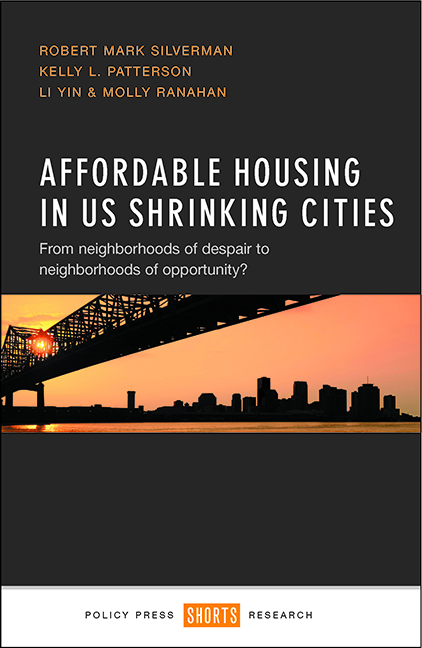 Affordable Housing in US Shrinking Cities
Affordable Housing in US Shrinking Cities Book contents
- Frontmatter
- Contents
- List of tables
- List of figures
- List of acronyms
- About the authors
- Acknowledgments
- Preface
- 1 Social equity and siting affordable housing in shrinking cities
- 2 Present-day Detroit
- 3 Present-day New Orleans
- 4 Present-day Cleveland
- 5 Present-day Pittsburgh
- 6 Present-day Buffalo, New York
- 7 Lessons learned and recommendations for siting affordable housing
- References
- Index
1 - Social equity and siting affordable housing in shrinking cities
Published online by Cambridge University Press: 01 September 2022
- Frontmatter
- Contents
- List of tables
- List of figures
- List of acronyms
- About the authors
- Acknowledgments
- Preface
- 1 Social equity and siting affordable housing in shrinking cities
- 2 Present-day Detroit
- 3 Present-day New Orleans
- 4 Present-day Cleveland
- 5 Present-day Pittsburgh
- 6 Present-day Buffalo, New York
- 7 Lessons learned and recommendations for siting affordable housing
- References
- Index
Summary
Introduction
This introductory chapter provides an overview of issues concerning social equity in the siting of affordable housing in US shrinking cities. The chapter begins with a discussion of US shrinking cities in the context of globalization. This discussion highlights how the sustained decline of older industrial cities in the US is the byproduct of their increased integration in the global economy. After establishing the emergence of US shrinking cities as a byproduct of globalization, the chapter turns to a discussion of the shift from an urban growth paradigm to one based on rightsizing in US shrinking cities. This discussion argues that globalization has led to the breakdown of urban growth regimes in shrinking cities and they are being replaced by rightsizing regimes led by hospitals, universities, and other nonprofit anchor institutions. In response to sustained shrinking, these rightsizing regimes adopt place-based urban revitalization strategies which focus on concentrating urban development in areas near anchor institutions.
The chapter then turns to a more focused discussion on emerging equity issues associated with rightsizing in shrinking cities. Empirical research examining the distribution of benefits that grow out of anchor-based revitalization is surveyed, with a specific focus on the implications of rightsizing for minority and low-income residents of inner-city neighborhoods. This discussion identifies the preservation and development of affordable housing as a linchpin for equitable anchor-based urban revitalization. In addition to identifying the provision of affordable housing as an essential ingredient in equitable anchor-based strategies, emerging tools for siting affordable housing are examined.
The final section of the chapter outlines the remainder of the book. It includes summaries of Chapters 2 through 6, which include case studies of: Detroit, New Orleans, Cleveland, Pittsburgh, and Buffalo. Each case study examines the relationship between emerging anchor-based strategies and a city’s distribution of governmentsubsidized housing. After presenting the case studies, the final chapter elaborates upon tools for siting affordable housing in US shrinking cities.
US shrinking cities in a global context
The proliferation of shrinking cities is a global phenomenon. It is found in places experiencing sustained population decline coupled with the deterioration of the built environment.
- Type
- Chapter
- Information
- Affordable Housing in US Shrinking CitiesFrom Neighborhoods of Despair to Neighborhoods of Opportunity?, pp. 1 - 22Publisher: Bristol University PressPrint publication year: 2016


